
Rosaceae, the rose family, is a medium-sized family of flowering plants that includes 4,828 known species in 91 genera.
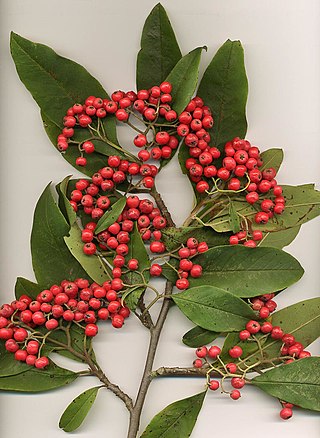
Cotoneaster is a genus of flowering plants in the rose family, Rosaceae, native to the Palaearctic region, with a strong concentration of diversity in the genus in the mountains of southwestern China and the Himalayas. They are related to hawthorns (Crataegus), firethorns (Pyracantha), photinias (Photinia), and rowans (Sorbus).

Cotoneaster franchetii is a species of Cotoneaster native to southwestern China, in the provinces of Guizhou, Sichuan, Tibet, and Yunnan, and also in adjacent northern Myanmar and northern Thailand.

Cotoneaster integerrimus, the common cotoneaster, is a species of Cotoneaster native to central and eastern Europe and southwest Asia, from southern Belgium and eastern France south to Italy, and east through Germany to the Balkans, northern Turkey, the Crimea, the Caucasus and northern Iran; plants in Spain may also belong in this species. In the past, it was treated in a wider sense, including plants from Wales now split off as Cotoneaster cambricus and plants from Scandinavia now treated as Cotoneaster scandinavicus, but differs from these in genetic profile and detail of foliage and fruit.

Cotoneaster pannosus is a species of Cotoneaster known by the common name silverleaf cotoneaster. This woody shrub is native to south central China but it has been introduced to other areas of the world, including southern Africa and Australia as an ornamental. It has become naturalized in some areas but it is a troublesome noxious weed in others, for example, in Hawaii. This is a sprawling shrub easily reaching over 3 meters in height. It is covered in dull green oval-shaped leaves with fuzzy white undersides and blooms in white flowers. The fruits are red-orange pomes containing two seeds each. These fruits are very attractive to birds, which are the main agent of seed dispersal. It grows on the elevation of 3,280 feet (1,000 m).

Cotoneaster horizontalis is a species of flowering plant in the genus Cotoneaster of the family Rosaceae.

Cotoneaster salicifolius, the willow-leaved cotoneaster, is a drought-tolerant, evergreen to semi-evergreen, low-lying, small to medium-sized shrub with an arched branching habit. Specimens growing in the wild, however, are generally larger, averaging five meters in height. Although native to the mountains, mixed forests, and open places in western China, it is commonly cultivated in temperate climates worldwide. Cultivars have been bred in a variety of forms, as ornamental groundcovers or shrubs.
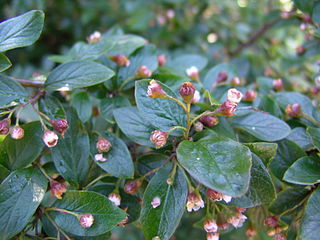
Cotoneaster lucidus, the shiny cotoneaster, or hedge cotoneaster, is a deciduous, medium-sized shrub with long, spreading branches reaching heights of 6' to 10'. It is native to parts of northern Asia, and adapted to tolerate colder weather (to zone 4). C. lucidus was described in 1856 by Diederich Franz Leonhard von Schlechtendal. Some authorities consider it to be a synonym of Cotoneaster acutifolius, the Peking cotoneaster.

Callisto denticulella is a moth of the family Gracillariidae. It is found in most of Europe, except the Balkan Peninsula and islands in the Mediterranean Sea. It is also known in Canada and the United States.
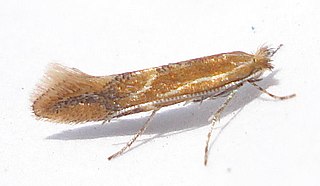
The hawthorn red midget moth is a moth of the family Gracillariidae. It is found in all of Europe.
Phyllonorycter deschkai is a moth of the family Gracillariidae. It is known from Alps on altitudes between 500 and 1,750 meters.

Phyllonorycter mespilella is a moth of the family Gracillariidae. It is found from Germany to the Iberian Peninsula, Sardinia, Italy and the Carpathian Mountains and from Ireland to southern Russia. It also occurs over much of western North America, from California north to British Columbia, and east to Utah and New Mexico.

Phyllonorycter sorbi is a moth of the family Gracillariidae. It is known from all of Europe, except the Balkan Peninsula.

Parornix scoticella is a moth of the family Gracillariidae. It is known from all of Europe.
Callisto pfaffenzelleri is a moth of the family Gracillariidae. It is known from the Alps and Slovenia.
Phyllonorycter hissarella is a moth of the family Gracillariidae. It is known from Tajikistan.
The apple tentiform leafminer is a moth of the family Gracillariidae. It is known from Kazakhstan, Kyrgyzstan, Russia (Altai), Tajikistan, Turkmenistan and Uzbekistan.
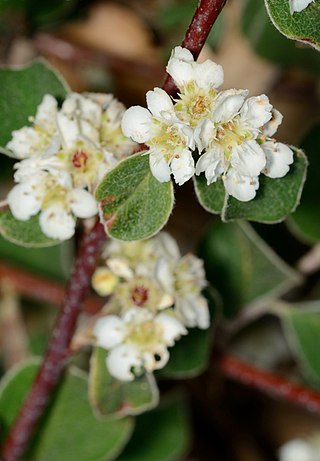
Cotoneaster nummularius, the nummular or coinwort cotoneaster is a species of cotoneaster. This woody shrub is native to much of Asia and south eastern Europe.
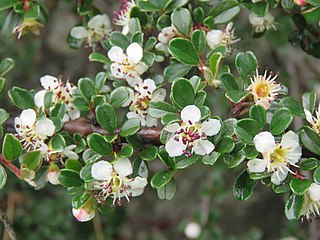
Cotoneaster microphyllus, the small-leaved cotoneaster or rockspray cotoneaster, is a species of flowering plant in the family Rosaceae. It is native to the Indian Subcontinent, Tibet, Sichuan, and Yunnan in China, and Myanmar, and it has been introduced to various locales in Europe, Australia, and the United States. A rabbit-tolerant shrub reaching 1 m (3 ft) tall but spreading to 2.5 m (8 ft), and hardy in USDA zones 5 through 7, it is recommended for rockeries and hedges. Care should be taken not to plant it where it can become invasive.











